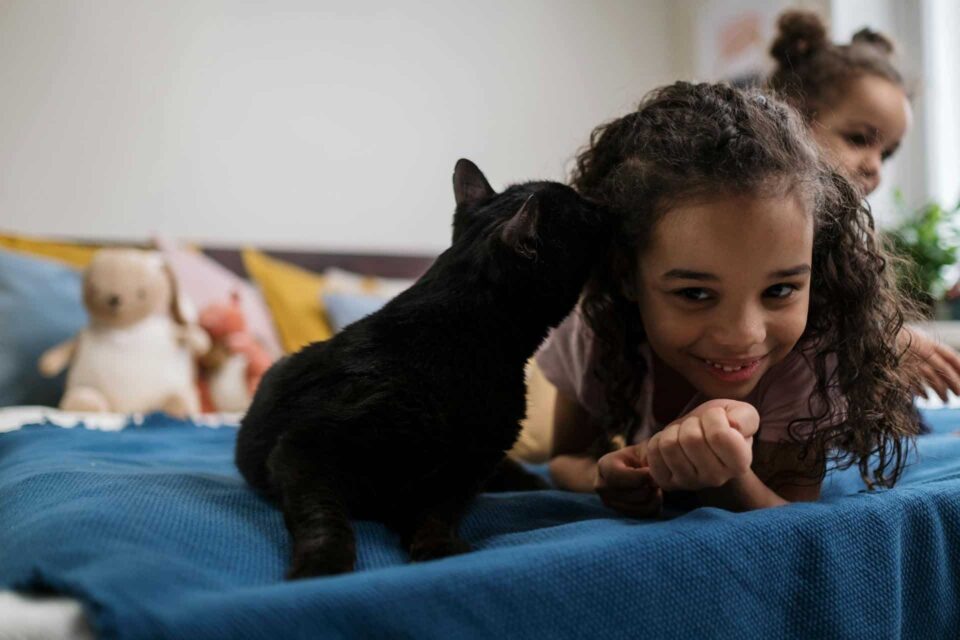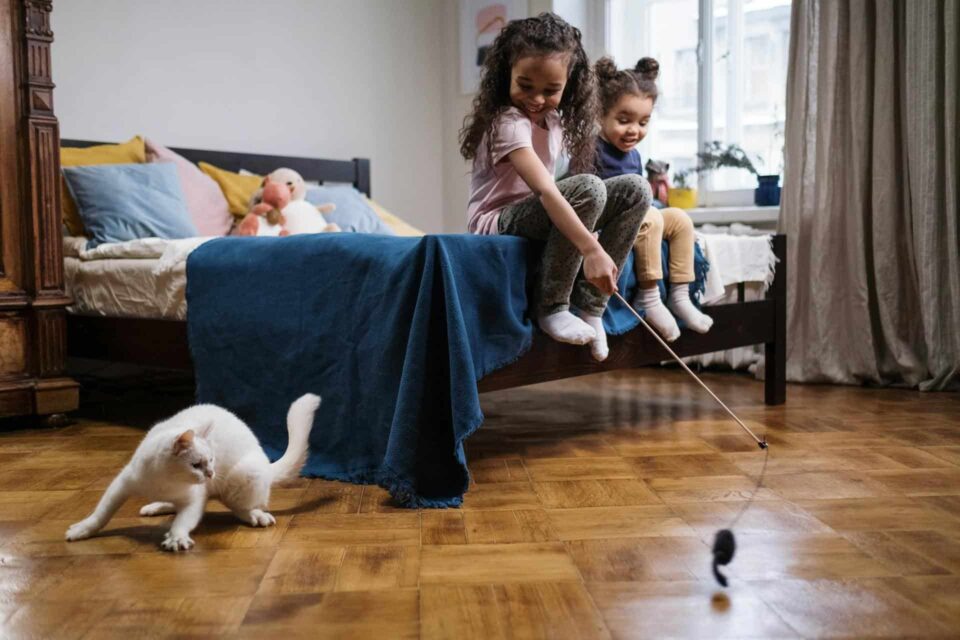Do Cats Understand Words? Here’s How We Can Communicate
Cats are fascinating creatures with a unique way of understanding the world around them. While they don’t process language like humans, they have their methods of recognizing and responding to our words and actions. By learning how to communicate effectively with our feline friends, we can strengthen our bond and better understand their needs and behaviors.
Key Takeaways
- Cats recognize certain words, especially those tied to specific actions or routines, like ‘treat’ or ‘bedtime.’
- Their understanding is more about associating sounds with outcomes rather than grasping the actual meaning of words.
- The tone and emotion in your voice significantly affect how cats perceive and respond to you.
- Communicating Nonverbally: Understanding Your Cat’s Language
- Consistent commands and positive reinforcement can help train cats to respond to specific words.

Understanding Feline Cognition
Cats are smart creatures but don’t understand human language like we do. Instead, they pick up on tone of voice and body language. When cats communicate with humans, they do so to get what they need or want, such as food, water, attention, or play. This means they can recognize certain words through association.
Comparing Cats and Dogs
Unlike dogs, cats haven’t been domesticated to follow human orders. Dogs are likelier to obey commands, while cats lead in interactions. This doesn’t mean cats are less intelligent; they have different ways of processing information.
Scientific Studies on Cat Communication
Recent studies show that cats can identify their owner’s voice and names. Researchers found that cats respond to their names with ear and head movements. This suggests that cats may not understand words but recognize sounds and associate them with actions or outcomes.
Recognizing Words: What Cats Can and Can’t Do
Common Words Cats Recognize
Similar to us, cats have varying intellect levels. While some cats may not be as responsive to human voice, others may be more attuned to it. Cats can generally recognize most words, especially if they are associated with familiar activities or routines. For instance, our feline friends may be able to swiftly identify terms like “treat,” “come,” or “bedtime” due to the typical behaviors that accompany these requests.
The Role of Repetition and Association
Cats connect a word’s sound to a specific result or response. Their comprehension is not so much of language as it is of tone and association. If you want your cat to identify a word with an action, you must be consistent. For particular acts or objects, always use a word that is similar and has the same tone. This constancy will eventually enable your cat to identify and respond to particular commands or words.
Emotion and Tone in Communication
Cats can hear the tone and emotion in our voices in addition to specific words. While a harsh or loud tone could be unsettling, a soothing and serene voice can be calming. This suggests that although our language’s semantics may be lost on them, its emotional overtones are not.
Although cats may recognize the sound of their name and their owners’ voices, they don’t understand human language. They respond to the tone and emotion behind the words rather than the words themselves.
Related: Feline Discomfort: How to Tell If Your Cat is in Pain
Communicating Nonverbally: Understanding Your Cat’s Language
Cats communicate using a range of nonverbal cues. You can decipher your cat’s signals by being aware of their body language and understanding their purrs and meows. Here’s how to communicate with your cat nonverbally in their language.
Body Language and Signals
Cats mostly use body language to communicate. A cat that has its tail up is normally content and self-assured; a cat that has its tail tucked in may be afraid. A closer relationship and understanding can be developed by paying attention to your cat and reacting to its nonverbal clues. Similarly, you can communicate with your cat by mirroring their body language. For instance, among cats, slow blinking might indicate trust and affection. Your cat can communicate silently if they return the motion when you blink slowly.
The Power of Slow Blinking
Blinking slowly is one of the most effective ways to interact with your cat. By simply blinking at your cat, you can communicate your trust and sense of security to it. Your cat will blink back if it agrees with you. This small act of kindness deepens your relationship and gives your cat a sense of security.
Mirroring Your Cat’s Actions
Mirroring your cat’s actions can help you communicate more effectively. If your cat rubs against you, try gently rubbing back. If they roll over, give them a gentle belly rub. By mimicking their actions, you show that you understand and respect their communication. This can lead to a more harmonious relationship between you and your feline friend.
Training Your Cat to Respond to Words
Training your cat to respond to words can be a fun and rewarding experience. Here are some tips to help you get started.
Using Consistent Commands
The secret to cat training is consistency. For the same activity, always use a similar word. Cats learn to correlate words with actions, so if you want them to come to you, say “come” instead of “here” or “come here.”
Techniques of Positive Reinforcement
Cats respond favorably to the reinforcement that they receive. As soon as your cat obeys your commands, show it some affection by giving it a treat or some praise. This encourages the behavior and helps your cat understand what you want. One of the most effective training tools is positive reinforcement.
Short and Effective Training Sessions
Make training sessions brief and enjoyable. Because of their limited attention spans, cats should only be trained for brief periods of time at a time. This keeps kids interested and stops them from becoming irritated or bored.
Training your cat to respond to words takes time and patience, but the results are worth it. With consistent commands, positive reinforcement, and short training sessions, you can teach your cat to communicate with you quickly.
Building a Stronger Bond Through Communication
The Importance of Talking to Your Cat
Regular conversations with your cat are crucial to building a stronger bond. Talk to them during petting sessions, folding the laundry, or bedtime. Regularly interacting with your cat using positive vocalization and gestures will reinforce your bond. It also provides insight into how your kitty uses their own verbal and nonverbal cat language to converse with you.
Engaging in Daily Conversations
Make it a habit to talk to your cat every day. Use a friendly tone and smile while speaking to them. This makes your cat feel loved and helps them understand your emotions better. Remember, cats are more vocal towards humans because it is the form of communication that we notice and respond to most easily.
Understanding Your Cat’s Responses
Pay attention to how your cat responds to your words and actions. Do they purr, meow, or rub against you? These are all signs that your cat is engaging with you. Understanding these responses, you can better communicate with your feline friend and strengthen your relationship.
Learning the essentials of cat communication and building a stronger bond are keys to a better relationship with your cat.

The Science Behind Cats Recognizing Their Names
Studies on Name Recognition
Cats can identify their names by sound, as you may have heard. According to research, cats frequently react to hearing their names by moving their heads or ears. Even if a complete stranger shouts the name, this is still true. Cats understand around 20-40 human words, but their name stands out because it usually means something important is about to happen, like getting food or playtime.
How to Teach Your Cat Their Name
- Employ Consistent Names: Don’t ever refer to your cat by a different name. Steer clear of nicknames and variants.
- Positive Reinforcement: When your cat responds to your name, show them your affection or treats. This establishes a favorable correlation.
- Practice Frequently: Make sure you have your cat’s attention by calling them by name. The link is strengthened by repetition.
- Keep It Brief: Cats’ attention spans are short. Training sessions should be succinct but regular.
Creating Positive Associations with Names
Cats learn through associative learning. When they hear their name and something good follows, they start to link the sound of their name with positive outcomes. This is why rewarding your cat when they respond to their name is crucial. Over time, this will strengthen their recognition and response.
It’s fascinating to think that while cats may not understand the concept of a name, they can still learn to respond to it through positive reinforcement and repetition.
Related:
Debunking Myths: What Cats Understand
Cats vs. Dogs: Obedience and Understanding
When it comes to obedience, cats and dogs are often compared. While dogs are known for their ability to follow commands, cats are more independent. Cats are not inherently aggressive unless they feel threatened. They might not sit or stay on command, but that doesn’t mean they don’t understand you. They just choose to respond differently.
The Limits of Feline Comprehension
Can cats understand language? Both yes and no. Cats are able to recognize some words, particularly those associated with treats or dinner, but their comprehension may use some work. They are not able to fully understand language the way humans do. Rather, they connect sounds to events or results.
Common Misconceptions About Cat Intelligence
Many people think cats are aloof and uninterested in humans. The truth is that cats are wary of humans and prefer to keep their distance. They’re not less intelligent than dogs; they express their intelligence differently. Cats are excellent problem solvers and can learn routines and commands through repetition and positive reinforcement.
While cats may not understand words like humans do, they can pick up on tone and body language, helping us communicate with them. To support your cat’s overall well-being and energy, try Gou Gou Pets’ Inner Fuel and Energy Boosting Shampoo, designed to revitalize and strengthen your cat’s coat. Keep your feline feeling fresh and energized with this specially formulated shampoo.
Conclusion
In the end, while cats may not grasp our words like we do, they pick up on our tones, emotions, and consistent cues. By understanding their unique ways of communication, we can build a stronger bond with our feline friends. So, keep talking to your cat, use consistent words, and pay attention to their body language. With patience and love, you’ll find that you and your cat can understand each other better than you ever thought possible.
~Veterinarian Recommended